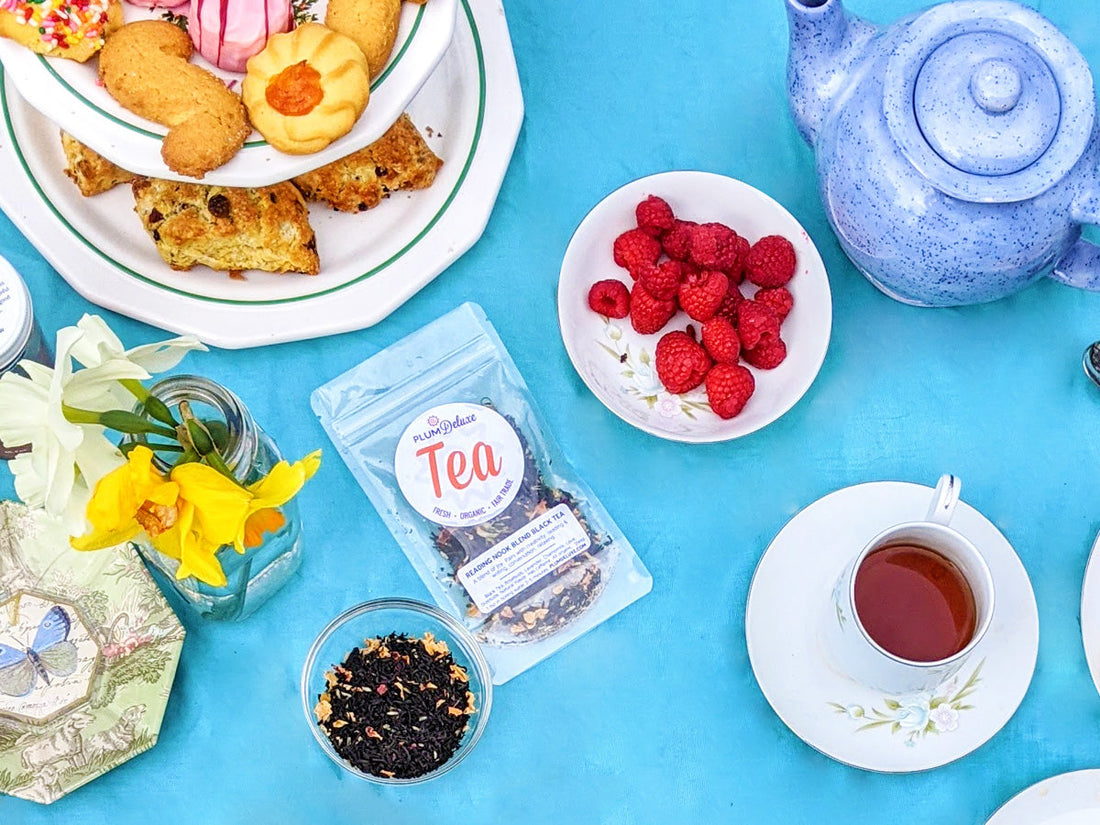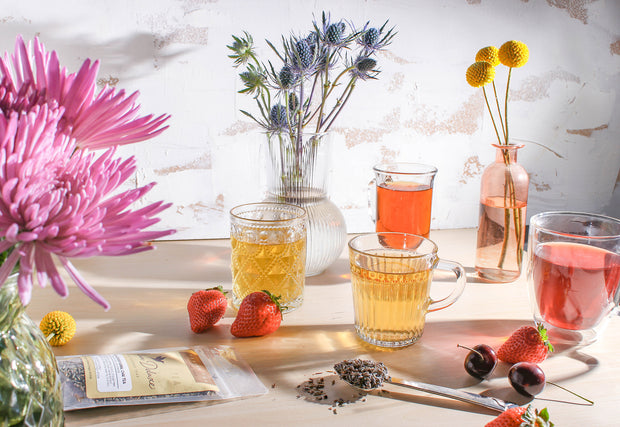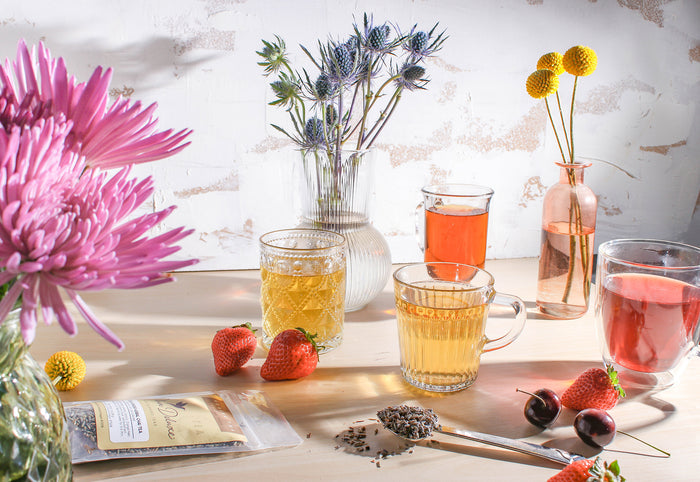During the winter holidays, my town puts on the "A Dickens of a Christmas" festival. Townspeople dress in Victorian garb and stroll the streets drinking mulled wine and eating a combination of local and old English food. Last year, I took a respite from the cold in The White Swan Tavern, a colonial era inn built in 1733. Inside, I found roaring fires, Christmas trees, and the best, most inviting afternoon tea I’ve ever indulged in.
You don’t need to stumble into an old inn wearing a crinoline to find the perfect tea; you can search for afternoon teas hosted by local inns and tea rooms, or you can immerse yourself in the fun of hosting your own! All it takes is some tiny food, creativity, and a good pot of tea.
What is Afternoon Tea?
Afternoon tea is an English tradition dating back to the 1800s of taking tea with three courses of finger food, sweets, scones, and savories or tea sandwiches. It’s a delightful and relaxing time to sit back and really savor tea, treats, and good company. Afternoon tea is usually laid out on fine china, with a large pot of tea and three tiers of treats acting as the centerpiece.
Afternoon Tea Party
To throw a tea party you need teaware, including a big tea pot, cream and sugar servers, and enough cups, saucers, and place settings for your guests. You will also need three courses of sweets, scones, and savories, traditionally served on a three-tiered serving stand. These could also be spread out on plates if you don’t have a server.
Throwing an afternoon tea party can be as classic as tea served on inherited china or it can be made more eclectic by gathering teaware from your local thrift store. You could even gift your guests with the mismatched tea cups at the end of your celebration.
If you like having a specific theme, try one of our tea party ideas or come up with your own using colors, seasons, books, movies, holidays, types of food, or whatever you can think of!
For my most recent tea party, I threw an early spring garden tea party for two on my deck using my grandmother’s china. I decorated with a brightly colored tablecloth (ok, it was a sheet) and daffodils picked from the garden. Throwing an afternoon tea party doesn’t need to be a big expenditure. Use your imagination and what you have around the house to create a look that is unique to you.

Afternoon Tea vs High Tea
Afternoon tea and high tea are often used interchangeably, but there is a difference between the two. Afternoon tea is not as fancy as most assume but is a more casual tea trademarked by the three types of finger food and a more relaxed setting. This gained it the name of low tea, due to often being served at a low coffee table or sitting room.
High tea is more of a light supper, served in the early evening, often at a dining table with heartier food options like meat, bread, eggs, and a full dessert. While afternoon tea is a social event, high tea is more of a necessary meal that first began in the lower classes, who did not have the idle time or finances for a social afternoon tea. Instead, they would arrive home from work in the evening to a meal served with tea. When the higher classes adopted this trend, it was more often used when servants weren’t available as a less formal meal time.
Just as there is a big difference between high tea and afternoon tea, an even less fussy tea option is the cream tea, which is tea served with scones, clotted cream, and jam.
Which type of tea you choose to throw will set the time of day and mood that you gather your friends.
What Time is Afternoon Tea?
Afternoon tea is served mid afternoon, intended as refreshment between lunch and a late dinner. The idea came from Anna, the seventh Duchess of Bedford, in 1840. Anna would become hungry around four o’clock in the afternoon and requested refreshment in the form of tea, bread and butter, and cake be brought to her room. This habit became a social event when she began to invite her friends for afternoon tea.
By the 1880’s, afternoon tea became such an event for high class society women that they would change into long gowns, hats, and gloves to be served in the drawing room between four and five o’clock. Today, afternoon tea times are often set by the teahouse, hotel, or inn which is hosting.

Afternoon Tea Etiquette
Put your pinky down. While afternoon tea isn’t a formal affair, there still are some bits of antiquated etiquette that should be followed at your next seating.
First, pinky up is an American myth; the tea cup should be held by its handle in one hand when sipping and placed in the saucer on the table when not. If you are standing, both saucer and teacup should be held at waist level.
Be mindful of your spoon. Stir in an up and down motion, from top to bottom of the cup, without clanging your teaspoon or leaving it in the cup – and certainly don’t put the spoon in your mouth.
At afternoon tea, food is eaten with the fingers in three courses. First is the savories and sandwiches, then scones, then sweets. Every person should have a setting with their own spoon for adding milk and sugar as well as a knife for cutting and slathering scones with jam, cream, or curd. Used utensils should then be lain on the right side of the plate, so as not to dirty the tablecloth. Scones should be broken in half, with each piece smeared and eaten separately. Scones and desserts should never be dunked into tea.
Most of these etiquettes are remnants from old high society, so take what you will, especially if you are hosting your own tea. Be a rebel, and dunk those cookies!
The main point of the rules is don’t be loud or make a mess, and be considerate of those around you. A more modern consideration would be not to leave your phone on the table where it could be distracting. Take tea time to mindfully enjoy your experience and the company around you.
For more on tea time etiquette, check out this podcast with Julia Livingston, The Happy Tea Time Lady.

What to Wear to Afternoon Tea
You may be wondering how to dress for such a gathering. While you are welcome to get as fancy as you like in your own home, typical afternoon tea attire is “smart casual,” which is a step below business casual – polished but comfortable.
This translates to a nice blouse or shirt paired with a skirt or slacks or a sundress. If you are hosting your own tea, dress can be whatever you want, but make sure you specify any expectations to your guests. Have some fun with it; maybe encourage styles from a certain era or floppy hats!
Afternoon Tea Menu Ideas
The real star of the party is the perfect pot of tea. I’d recommend at least two types, depending on how many people you are having. One caffeinated black or green and one tisane will give your guests options and the ability to keep pouring tea without becoming over caffeinated.
Plum Deluxe has an extensive list of options for any taste. If you want to go classic, then brew up a pot of Earl Grey like the creamy Mindful Morning, or serve Earl Grey with a twist of strawberry with Gratitude Blend. Another classic option would be a strong, black builder’s tea. Fog Cutter is an Irish breakfast blend with a hint of lemon that makes the perfect cup of builder’s tea. Reading Nook is a smooth, lightly sweet floral tea that would be a perfect blend for an afternoon tea party; the best chamomile, rose, and lavender went perfectly with my garden theme.
Green tea is a lighter option for serving at an afternoon tea party. The jasmine in Hope Blend makes for a luxuriously scented pour, while Garden Grove is a lovely accompaniment to any garden party with its cherry and vanilla jasmine flavor.
If I had to choose just one tisane to serve, I would pick Slowly Unwind, which is a delicate and slightly fruity blend of elderflower and berry that is made for slow sipping.

After choosing tea, it’s time to plan out your food menu. Laura from Crumbs on the Table suggests that most teas focus on more sweets to savories when planning the menu. “My hunch is that the savouries are there in the traditional spreads to make it possible to eat a greedy variety of sweeter things without a total blood-sugar collapse.”
She suggests serving a more balanced proportion per person: four small sandwiches of two to three kinds, one average or two small scones that could be a mix of savory and sweet with jam and cream, and one or two pieces of cake or pastry, all decorated with salad or fruit garnishes. This comes out to about three savory and three sweets per person. I prefer to keep with the finger foods and offer a variety of small sweets rather than cakes that need cutting and cutlery.
There are so many ideas and options out there for delicious food for your afternoon tea, but don’t feel you have to take it all on yourself! When tea times were popular, so was the concept of having a staff to run your home. You could pick a recipe or two – maybe red velvet scones with a cream cheese spread or traditional or chocolate cardamom tea cakes – then supplement some of the menu from your local bakery or grocer. Cakes, quiches, and scones can be made the day ahead, but sandwiches generally need to be made or picked up shortly before the guests arrive.
Afternoon Tea Recipes
My favorite scone to make is a lightly sweet white chocolate lavender scone served with lemon curd. I like the bright freshness of the lemon curd against the sweet floral notes of the scone, plus it makes a surprising and impressive colorful addition to the table with little effort. Both the scone and curd can be made the day before if wrapped well to preserve freshness. This scone pairs especially well with Earl Grey and floral teas.

Lavender White Chocolate Scones
Ingredients:
- 2 and 3/4 cups of flour
- 1/3 cup sugar
- 3/4 teaspoon salt
- 2 teaspoons baking powder
- 1/2 cup cold butter
- 1/2 cup white chocolate
- 1 tablespoon dried lavender
- 3 large eggs
- 1 teaspoon vanilla extract
- 1/2 teaspoon almond extract
- 1/2 cup heavy cream
- Turbinado sugar
Directions:
- In a large bowl, mix together flour, lavender, sugar, salt, and baking soda.
- Dice the butter, then cut into the dry ingredients until most of the butter is pea sized.
- Mix together 2 eggs, vanilla and almond extract, and heavy cream in a separate bowl.
- Make a well in the dry ingredients, and pour in the wet ingredients.
- Mix until dough comes together, adding heavy cream or flour in small amounts if needed. Mix in white chocolate. Don’t over-mix dough.
- Place half of the dough mixture onto a covered, floured baking tray. Press the dough in a flat circle until it is about 6 inches across. Cut circle into 8 triangles and separate by one inch. Repeat with second half of dough.
- Place scones in the refrigerator or freezer for half an hour.
- Preheat oven to 425.
- Whisk an egg and use a pastry brush to brush it onto the tops of the scones. Sprinkle liberally with coarse sugar.
- Bake 18-20 minutes, or until the tops of the scones are golden brown.
Lemon Curd
Ingredients:
- 6 teaspoons fresh lemon juice (from about 3 lemons)
- 1/2 cup sugar
- 4 large egg yolks
- Pinch of salt
- 4 tablespoons butter
- 2 teaspoons lemon zest
Directions:
- Zest, then juice, lemons. Pass juice through a strainer to remove seeds.
- In a heavy-bottomed saucepan, whisk lemon juice, sugar, egg yolks, and salt. Cook over medium-high heat, whisking constantly and scraping sides of pan until curd is thick enough to coat the back of a spoon, about 5-8 minutes. Do not let it boil or the curd will get lumpy. If this happens, pass through a fine strainer.
- Remove from heat and whisk in butter one tablespoon at a time until smooth.
- Stir in zest, then cover with plastic wrap, pressing directly onto curd so as not to form a skin.
- Refrigerate until set, at least one hour.

![Spring Break Tea Variety Pack [6-Pack Variety of Flavors]](http://www.plumdeluxe.com/cdn/shop/files/spring-break-pack.jpg?v=1740682266&width=165)















